
If you’ve been reading on this site for a while you know that I absolutely adore intermittent fasting.
It’s a tool that makes fat loss easier, mainly by buffering calories for later in the day. And it also makes staying lean easier when bulking to pack on new muscle mass.
There are many different approaches to intermittent fasting, but this intermittent fasting guide lays out the most effective approach by far, an approach that I like to call “Flexible Fasting”.
The power with this approach, as opposed to most approaches out there, is that it doesn’t overcomplicate your eating pattern and turn fasting into a burden. For example, having to stick to an exact fasting and feeding window can be very difficult. Also, some other types of intermittent fasting utilize longer fasts lasting 24+ hours, which is extremely tough and unnecessary.
I have been utilizing the intermittent fasting strategy laid out in this guide for just above three years now! It has been hands down the most effective and enjoyable nutrition “hack” I have ever come across.
In this guide I’ll break down what makes intermittent fasting so powerful, I’ll cover the concept of Flexible fasting in detail, and also discuss where you should place your training when using intermittent fasting to get the best results possible. Once you’re done reading you should be equipped with one of the best physique developing tools on the planet.
Table of Contents
What is Intermittent Fasting?
Intermittent fasting is a period of time when you choose to avoid eating food and calorie including fluids. Fasting is common within different religions, and it is also widely spread in the fitness industry.
I believe that intermittent fasting will be, if it isn’t already, a mainstreamed method within fitness and health circles in the nearest future. Every day, more people find out just how easy it is to build good looking and healthy bodies with the help of intermittent fasting.
Fasting through evolution, religion and modern science
To fast because of health reasons is done with the purpose of clearing the body of waste products, stimulate the body’s metabolism and cell production as well as strengthen the immune system.
In religious circles, there’s similarities and connections with the modern beliefs of fasting as well, namely that fasting is used for spiritual renewal, cleansing processes and replenishment for both the body and soul.
Also, when looking at human evolution, mankind was forced to fast during the era where basic necessities, such as food, clothing and shelter, weren’t as easily available as they are today.
Furthermore, fasting is also something that we do every night when we’re asleep.
So, with support from modern research showing benefit after benefit when it comes to fasting, with the knowledge that fasting has been adopted for thousands of years in most of the religions, and that in the hunting and gathering society, before either science or religion existed, we had to fast in order to survive, I see no problems with adopting fasting today.
Rather I think that we’re evolutionary customized to not only be able to fast, but to also feel better and thrive on doing so.
Benefits of Doing Intermittent Fasting
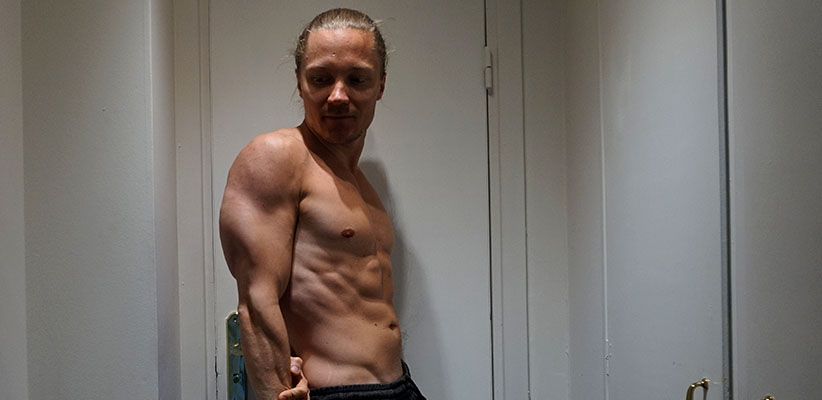
A huge component of learning how to do intermittent fasting is getting used to skipping breakfast and extending your overnight fast into the day. By doing this, some amazing benefits starts to take place. Let’s look at these:
Benefit #1 – Increased fat burning with the release of growth hormone, adrenaline and noradrenaline
During the fasted periods, hormones such as adrenaline, noradrenaline and human growth hormone increases.
Adrenaline and noradrenaline releases stored body fat and sugar from the cells out into the bloodstream, making it available as energy for the body.
Human growth hormone has the role to preserve muscle mass as well as increase the release and start mobilization of the stored body fat and sugar, similar to the way that adrenaline does. This makes it even easier for the body to use stored body fat as energy.
To simplify, these hormones get released so that the body can use its own stored energy (mainly body fat) when there isn’t any food available. This is a very healthy and natural process for the body and it’s exactly what it’s evolutionary created to do. It also leads to increased fat loss further down the line!
Benefit #2 – Better insulin sensitivity
When human growth hormone and adrenaline increases, your insulin levels simultaneously decrease. Insulin is the body’s most anabolic hormone and it’s only significantly present in the body after food intake, especially following intake of carbohydrates, but also protein, to a certain degree.
Insulin sensitivity refers to when the cells in your body can “easily” store and take care of the carbohydrates you eat, in other words, they’re sensitive to insulin. When you eat carbohydrates, the body will transform them into glucose, which is the simplest form of carbohydrate which the body can then use to store as glycogen in the muscles and liver.
With intermittent fasting, you increase your insulin sensitivity by forcing your body to use your stored glycogen and fat from your cells during the period of fasting. By doing this, you can better direct carbs into your muscle stores and away from fat storage once you start your feeding window.
Benefit #3 – Increased mental sharpness during the day – satisfied, happy and sleepy during the night
We have something called The Central Nervous System (CNS). The CNS is our processor (in computer language) which gathers all information that happens both inside and outside our body and sends it to the brain. The brain then processes this information and sends out signals to all of our organs to perform certain tasks to keep us alive.
The part of the CNS that’s connected to food is called the autonomic nervous system, which is a system that we can’t directly control ourselves. We can however change how it should be expressed, since it’s automatically regulated by things like daily rhythm, meals, physical or mental activity and other activities that we do.
The autonomic nervous system have two different “subsystems” which are the opposite of one another and they’re called:
- The sympathetic nervous system
- The para-sympathetic nervous system
These systems can easily be described with the metaphor of a balance board:
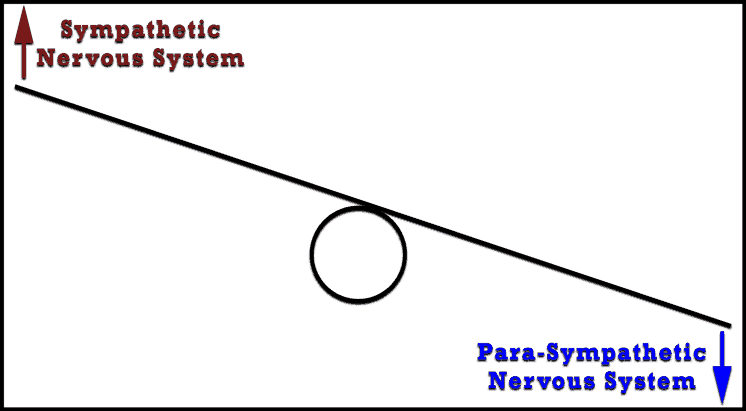
When the sympathetic nervous system increases, the para-sympathetic nervous system simultaneously decreases and vice versa. Having a balanced activity between these two seen over days and weeks leads to health and well-being.
The sympathetic nervous system – Increased mental sharpness
This system becomes more activated when you’re exposed to physical, mental, and emotional stress, which would be fight or flight situations, and it prepares the body for physical activity.
Your blood flow to the muscles increases, your pulse and blood pressure increases, your pupils gets dilated, and as various hormones increases which releases your body’s stored energy reserves to be used as accessible energy. (This is why you burn fat so effectively during the fasted window)
When our sympathetic nervous system increases, i.e during our fasted window, it causes much stronger mental sharpness and alertness. It’s not uncommon that people get the same feelings of alertness and freshness that they get through caffeine consumption, without even having to drink caffeine included beverages such as coffee or energy drinks.
The para-sympathetic nervous system – Increased satiety, happiness and calmness
Contrary to the sympathetic system, this system becomes more activated when the body is at rest and in lack of stress.
When activated, your heart activity and blood pressure decrease, your level of stress hormones decrease and “feel good” hormones such as oxytocin increases. Blood flow increases in your digestive system, which supports the processing of food, and the body’s healing processes improves.
When our para-sympathetic nervous system increases, i.e during our feeding window, we experience feelings of being relaxed, happy, calm and peaceful.
Fasting Aligns Yourself With Your Natural Instincts
For long we’ve been told that breakfast is the most important meal of the day and that we should eat small at night if we want to be lean and healthy. This is a big myth!
The truth is that humans have evolved to eat smaller during the day and feast at night. In fact, breakfast is a relatively recent event. The idea that breakfast is the most important meal of the day has largely been pushed by cereal and other breakfast food companies to increase the sales of their products.
If you look at the ancient Greeks, who’re arguably the finest people to ever live, both physically and mentally, they ate just around two meals per day, those meals being lunch and dinner. They were obsessed with digestion and to eat very often was considered a form of gluttony.
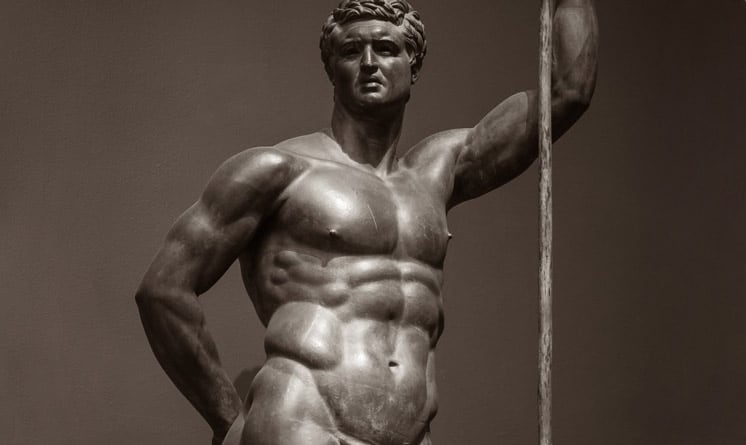
By skipping breakfast and eating large and satiating meals, dieting becomes far more enjoyable. Simply because you’re now eating in accordance with your genetic code instead of against it.
Most people function best when using an intermittent fasting protocol where they fast during the first part of the day and feast during the second part of the day. This is true because of the sympathetic and para-sympathetic shifts I talked about earlier.
How Intermittent Fasting Will Help You Get Ripped
As you can see from these benefits above, fasting is not only possible, it’s also a very healthy and natural process for the human body to undergo. In today’s society we’re stuffing our face with food constantly, there’s no wonder that the obesity rates are as high as they are.
With a strategic use of intermittent fasting you can shift your body into using it’s own stored energy for a few hours which is an amazing way to help you get and stay ripped long-term.
Catabolism vs. Anabolism
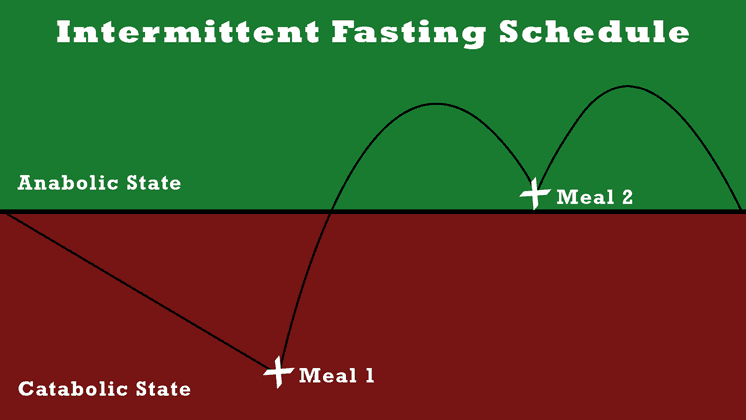
When we’re in the fasted window we turn on our catabolic pathways in the body which leads to the body using it’s stored nutrients as fuel. On the other hand, when we’re in our feeding window we turn on our anabolic pathways which leads to the body storing nutrients in our bodies.
What we want to do is withstand enough time in the fasted state to experience heightened growth hormone levels, improved insulin sensitivity and increased fat mobilization without becoming too catabolic.
Therefore I recommend keeping the fasting length in the ball park of 14-18 hours. Some people will prefer longer fasts and other people will prefer shorter. I have experienced great results with both protocols.
Calories And Macros Still Matter Most
Now, it’s important to note that for true long-term fat loss to occur you must still pay attention to proper nutrition. If you’re eating a poor diet fasting will do very little for you.
For one, it’s possible to overeat on calories when fasting, which means that you can still store unwanted body fat even when you’re using intermittent fasting. Secondly, it’s also possible for you to eat too little protein to maximize muscle growth.
With this said though, intermittent fasting makes it much harder to screw these things up. And there are a few reasons why:
- Intermittent fasting makes eating healthier easier because you start to crave natural wholesome foods like protein, starches and veggies.
- Since you’re eating only 2-3 meals per day dieting becomes a breeze, you barely have to think about it.
- With each meal you have a lot of calories to work with, which gives you a ton of options for amazing and downright satisfying meals.
- Fasting affords you the luxury to be able to eat out at restaurants without blowing your diet.
- Fasting makes it incredibly easy to incorporate treats into your meal plan without going over your calorie numbers.
So, understand that as far as fat loss and muscle growth is concerned, calories and macros still matter most. Fasting simply makes everything regarding the diet more enjoyable while also promoting some of the incredible physiological benefits mentioned earlier.
Intermittent Fasting When Cutting
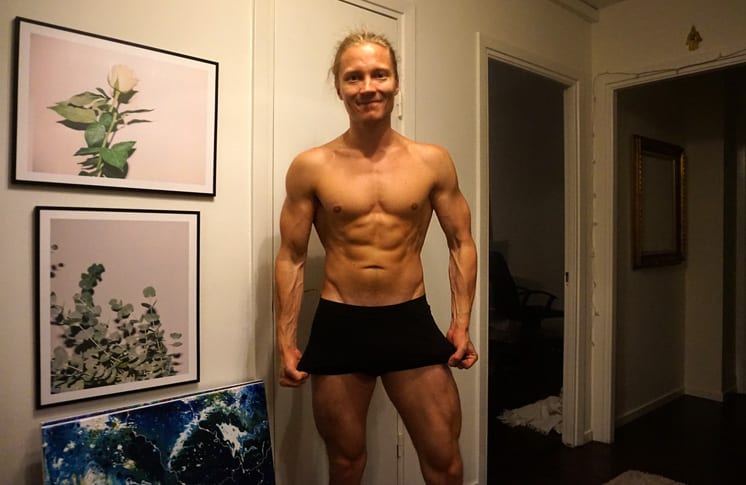
This is where intermittent fasting really shines! Cutting body fat is all about placing yourself in a calorie deficit, while eating enough protein and focusing on getting stronger in the gym. Intermittent fasting helps a ton with the calorie deficit part.
Here are the five benefits of intermittent fasting that was covered in this article; Intermittent Fasting for Fat Loss – The 5 Big Benefits That Will Help You Get Ripped:
- Create a huge food budget for later in the day – The main benefit of intermittent fasting is that you can save up on huge amounts of calories for later in the day, where most of us are genetically more hungry and want to eat.
- Improves satiety and satisfaction when cutting – By postponing your calories for later in the day you can eat a ton of satiating and satisfying foods without gaining fat. The sympathetic nervous system activity will reduce hunger in the morning.
- Enables you to more easily participate in social events and gatherings – By saving a large budget of calories for the evening you no longer have to say no to social events and gatherings because you don’t want to experience the hassle of resisting food all night. Instead you now have room for it!
- Saves you time – Not having to spend a ton of time cooking and eating food leads to huge freedom feelings for most people. This aligns perfectly with how we live today as well, we’re always in a rush heading to work or school during the morning and days, while we’re relaxing and enjoying time together at the night.
- Every meal will feel like a cheat meal – A lot of people feel the urge to have large cheat meals when cutting to lose body fat. With intermittent fasting each and every meal will be huge and satiating. Essentially you get the feeling of a cheat meal each time you eat, even if the meal is made up of mostly “healthy” foods.
Intermittent Fasting When Bulking
There’s no doubt that intermittent fasting is an extremely powerful tool when it comes to losing body fat. But it’s also a strong tool when it comes to building muscle as well. The main benefit of intermittent fasting is that it makes it much easier to stay lean when bulking.
And it do so in the following three ways:
- By providing a smooth transition between cutting and bulking – If you’re using intermittent fasting when cutting you should continue doing so when you start to bulking. If you don’t you risk fat spillover once you transition between cutting to bulking. This is because your body is now used to eating big in the evening. If you add food in the morning you might still have the appetite to eat large in the evening so you gain fat from the extra calories added in the morning.
- By making it harder to overeat – Keeping a shorter feasting window makes it very hard to overeat. If it can help you avoid eating too much when you’re in a deficit it’ll definitely help you when in a surplus.
- By improving nutrient partitioning slightly – Since you’re “manipulating” catabolic and anabolic periods when fasting, you can improve lean muscle growth while minimizing fat gain.
If you’re interested in learning more I covered these benefits deeply in this article.
How to Set up Your Intermittent Fasting Schedule (Flexible Fasting)
Let’s get to the intermittent fasting approach that I’ve found to be the most effective and enjoyable one out there. Here’s how to set it up step by step:
Step 1: Ditch the strict eating and fasting window
The biggest reason some people struggle with fasting is because they stick to an arbitrary 8 hour feeding window, like 12 to 8 pm. This type of restriction is negative in a few different ways.
The problem with this approach is that people rise at different times in the morning, on different days. Sometimes people wake up around 5 to 6 am and force themselves to fast until 12 pm because that’s what their schedule says.
While on other days they wake up at 8 or 9 am and only fast until 12 pm. Sure the fast was shorter and easier, but this time they started fasting at 8 pm in the evening and perhaps went to bed at midnight, having to resist eating for many evening hours.
The power of intermittent fasting comes down to spending a good chunk of the day in the fasted state. It’s not about following some arbitrary eating window such as between 12-8 pm. What’s important is that you try to fast for as long as you feel is appropriate based on how your day looks.
Postpone your first meal 4-7 hours into the day
Ideally you should aim to postpone your first meal 4-7 hours after you wake up. What this does is making the already easy method intermittent fasting even easier by removing a huge part of it’s restrictiveness.
In fact, the more flexible you can be with your approach the easier you will have sticking to it long-term. Truth is that humans are terrible at depending on willpower and the “secret” with the Flexible Fasting approach is that you’ll remove having to depend on willpower at the hardest part of the day to do so, which is during your evenings.
In fact, think of willpower as a battery. When you wake up your willpower is 100 % charged and you feel ready to crush your day.
At this time your battery is full.
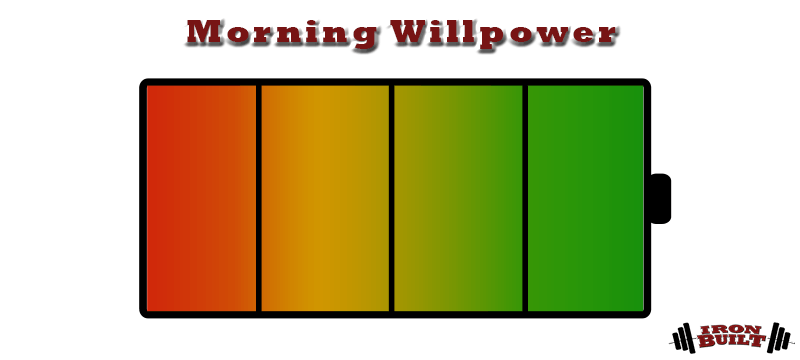
During the day, you make thousands of decisions which all take their share of willpower from your battery. So at night, depending on the magnitude of your daily tasks your willpower status may look like this:
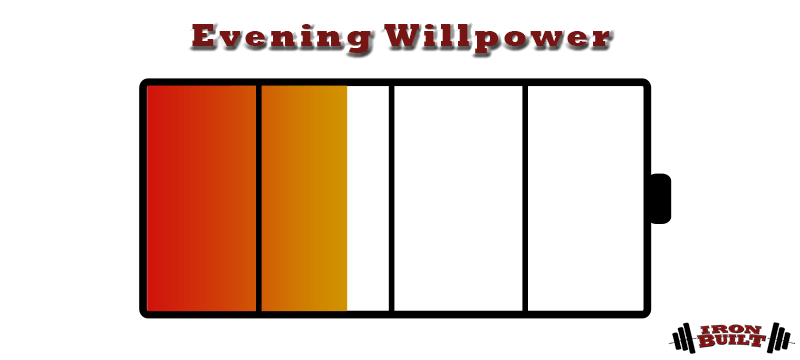
This is perfectly normal and why we need food, relaxation and sleep to replenish our system.
Managing willpower can be the difference between regularly going on binges and periods of yoyo dieting, or having a healthy eating pattern and successfully getting and staying lean long-term!
Actually, when you force yourself to stop eat at say 8 or 9 PM like you would with the usual 16:8 protocol, then you must depend on willpower when you’re already in the red zone!
Having to resist eating with low willpower is not an easy situation to be in, neither is it comfortable, the risk of going on a binge is extremely high during this time.
It’s also a time when people want to eat and enjoy food together. You can see where I’m going with this, right? That it’s much easier to decide for yourself when to start and stop eat as long as you’re at least fasting for the first 4 hours per day on top of your hours asleep.
Step 2: Use tricks that will make your fasting window easier
Here’s the deal; when people first get started with intermittent fasting it’s very common that they experience hunger, lightheadedness, headaches and other weird feelings during the fasted window. This is usually because the sudden change in bigger separate sympathetic and para-sympathetic nervous system activity.
These feelings will go away within 1-2 weeks for most people. Now with that said, there are a few tricks that can effectively reduce these “bad” feelings during your fasted window, and further improve your fasting experience as you become more used to it as well.
In the post 8 Intermittent Fasting Tricks That’ll Make Your Fast Feel Like a Breeze I covered the best strategies for making the fasting window downright easy and enjoyable. To avoid repeating myself here’s a short list of the tricks that you can use yourself:
- Know that you won’t starve to death – Humans can survive for around 3 weeks without food, that’s a long freaking time! So go in with that mindset and you’ll be fine if things start to feel a bit uncomfortable.
- Stay well hydrated – Drinking water is not only a trick, it’s a necessity. But when it comes to fasting it’s very effective at blunting appetite. One thing that’s common in today’s age is mixing hunger with thirst. Very often the hunger that we experience is actually just thirst, especially during the morning hours.
- Strategic use of caffeine – This is the crème de la crème when it comes to blunting appetite. Studies show that caffeine has a strong hunger reducing effect while it promotes mental and physical activity. Caffeine also improves calorie burn and hence makes fat loss easier.
- Move around/stay active – Believe it or not, staying active actually blunts appetite, especially in combination with fasting. Staying active gets your mind off of eating by changing your mental state. Not only that, staying active also makes you feel better during your fast. This is because the elevated stress hormones “wants” you to move around. This is an adaptation that we humans made over thousands of years when we didn’t have food available in the same way we have now.
- Eat a fruit – This is a strategy that I got from Greg over at kinobody.com. The fructose in the sugar helps you restore some of the emptied liver glycogen caused by fasting for 15-17 hours. This effectively blunts appetite while only providing 75-100 calories. Great for extending the fast another couple hours for even bigger meals later in the day.
- Get enough sleep – Sleep is the most important aspect for recovery, arguably more so than food. Research has shown that if you’re not sleeping well, you will see huge negative effects on your physique development. You’ll also lose control over your impulses with poor sleep, which means that skipping food as you’re supposed to during your fasted window will be very hard to do both physically and mentally.
Step 3: EAT BIG!
The thing about intermittent fasting is that you’re going to have much bigger meals than what you’re likely accustomed to, which is awesome! With that said, it’s important that you adjust the size of your meals accordingly. If you don’t adjust your meals you will end up eating very few calories and nutrients, which means that hunger will be pronounced during the fast, making it much harder to stick to.
It’s important to eat a large lunch and dinner with a snacks or two in between, make this meals to small or skip one and you’re at the risk of becoming very hungry. In addition to this, you should also aim to get enough protein in each of your meals to ensure optimal muscle growth and satiety.
It’s not uncommon that I eat lunch and dinner meals that weigh 2-3 lbs in order to get enough calories and nutrients in. At first, expect to be incredibly full! In fact, I sometimes have trouble finishing my meals even though I’m dieting and losing fat. This is what you want if you’re going to successfully get rid of your body fat long-term.
Just make sure you’re eating yourself full, otherwise you’ll end up in a calorie deficit that’s too large and your fasted window will turn into hell. So, don’t be scared of eating more than what seems reasonable!
Step 4: Forget About The Fast
This is important, by not thinking about how long you’ve been fasting for and by not making such a big deal out of it, it will start to feel completely natural. When something feels natural to us, we make it into our lifestyle, and when it’s our lifestyle that’s when we will see the long-term results that we’re after!
This is true regarding most of the things we do, especially when it comes to fitness and building your physique. The more you make it into who you are, the more successful you will become!
Where to Place Your Workouts When Doing Intermittent Fasting
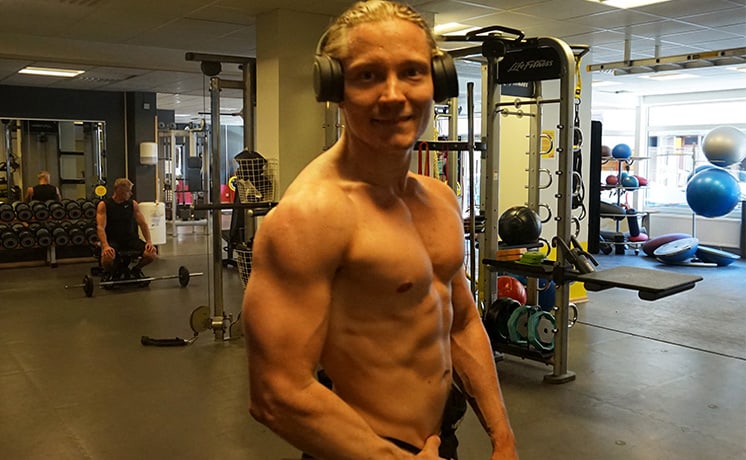
Recent research has shown that nutrient/protein timing around your workouts isn’t that important for muscle growth as we previously thought. Hitting your calories and macros for the day is way more important than when you eat.
With that said though, to maximize your muscle growth it’s recommended that you’re not delaying your post-workout meal more than 2 hours if you didn’t have a large pre-workout meal that day.
When using intermittent fasting you can train anytime you want after your first meal. You can even train after your last meal if you so like, because you would have all the nutrient (amino acids) in your body ready to maximize your muscle building process. This is because, if you had a large dinner before working out your food wouldn’t be digested and absorbed yet.
But if you’re training early in the morning, then it wouldn’t be ideal to postpone your first meal until lunch. Here’s why:
During this scenario, you would still make gains since muscle protein synthesis starts to climb 3-4 hours after training, peaks at the 24 hour mark and then decreases until it’s back to baseline 36-48 hours after the training was completed, so it’s okay training in the morning, especially if you’re a beginner. But, if you’re an intermediate to advanced trainee, delaying your post workout meal when you’re also fasted, may compromise the rate of muscle growth a bit.
If you must train early in the morning, then I recommend that you have a protein shake or another lean source of protein after your workout. You wouldn’t be fasting anymore, but you would still save most of your calories for later in the day/evening, which is the biggest benefit of intermittent fasting.
Strategically Place Your Training to Take Advantage of Nutrient Partitioning
Before finishing up this guide, I want to shine some light on another reason why I recommend you place your training either right before your first meal, or somewhere within your “feeding window”.
Some interesting research shows that intermittent fasting can cause better nutrient partitioning in the body if it’s combined with resistance training. Improved nutrient partitioning means that more nutrients will be used for replenishing glycogen and repairing and building muscle, as opposed to getting stored as body fat.
This happens because of catabolism and anabolism that we touched on earlier:
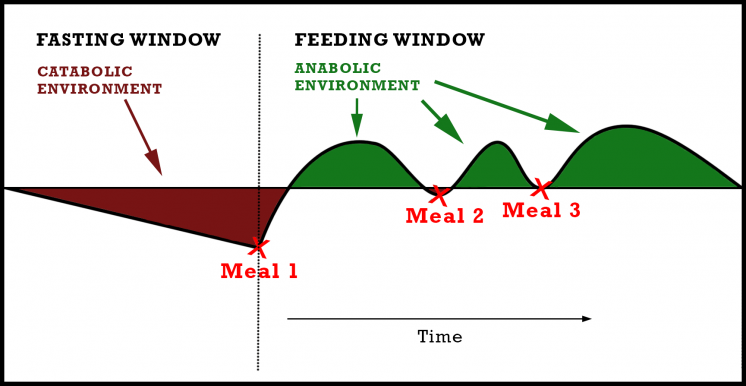
As you can see in this image and as I covered earlier, when you’re using intermittent fasting you first create a large catabolic environment in your body during your fasted window (the red area). Then once you start eating, you create a large anabolic environment instead (the green area).
After your body’s been in a prolonged period of catabolism, i.e fasting, the sensitivity of different hormones gets upregulated in your muscles. In other words, your muscles get extremely hungry, which is natural since you haven’t eaten anything for a long time.
And here’s where it gets interesting:
If you place your training either right before your feeding window or somewhere in it, more of the nutrients you eat during your feeding window will go towards muscle growth. This is true since you provide your body with nutrients only during times when your muscle building process is mostly activated.
This means that the majority of the nutrients you eat will go towards repairing and building new muscle tissue instead of being stored as body fat! Now, it’s unlikely that all your calories will go towards muscle growth, but a larger portion of it might.
I’m emphasizing might because research isn’t completely clear if this really is the case. More data must be available before making any definite assumptions.
However, it’s still a cool benefit and even if the partitioning effects are small, it might still make a significant difference seen over years of training.
What’s Next?
There we go, you should now be equipped with one of the best tools for building a lean and muscular physique. Now, it’s worth mentioning that intermittent fasting is just a tool to make everything regarding your diet easier. To successfully get the physique you want you still need to set up your nutrition and training correctly.
If you want to learn exactly what to do in order to build the physique of your dreams, then I recommend reading the guide: How to build an aesthetic physique. You can read it by clicking here!

I need help with my schedule and fasting. So I wake up around 4am and leave my house around 5 to get to my CrossFit Class at 6:15am. What’s the best schedule for me to fast when I start my mornings so early?